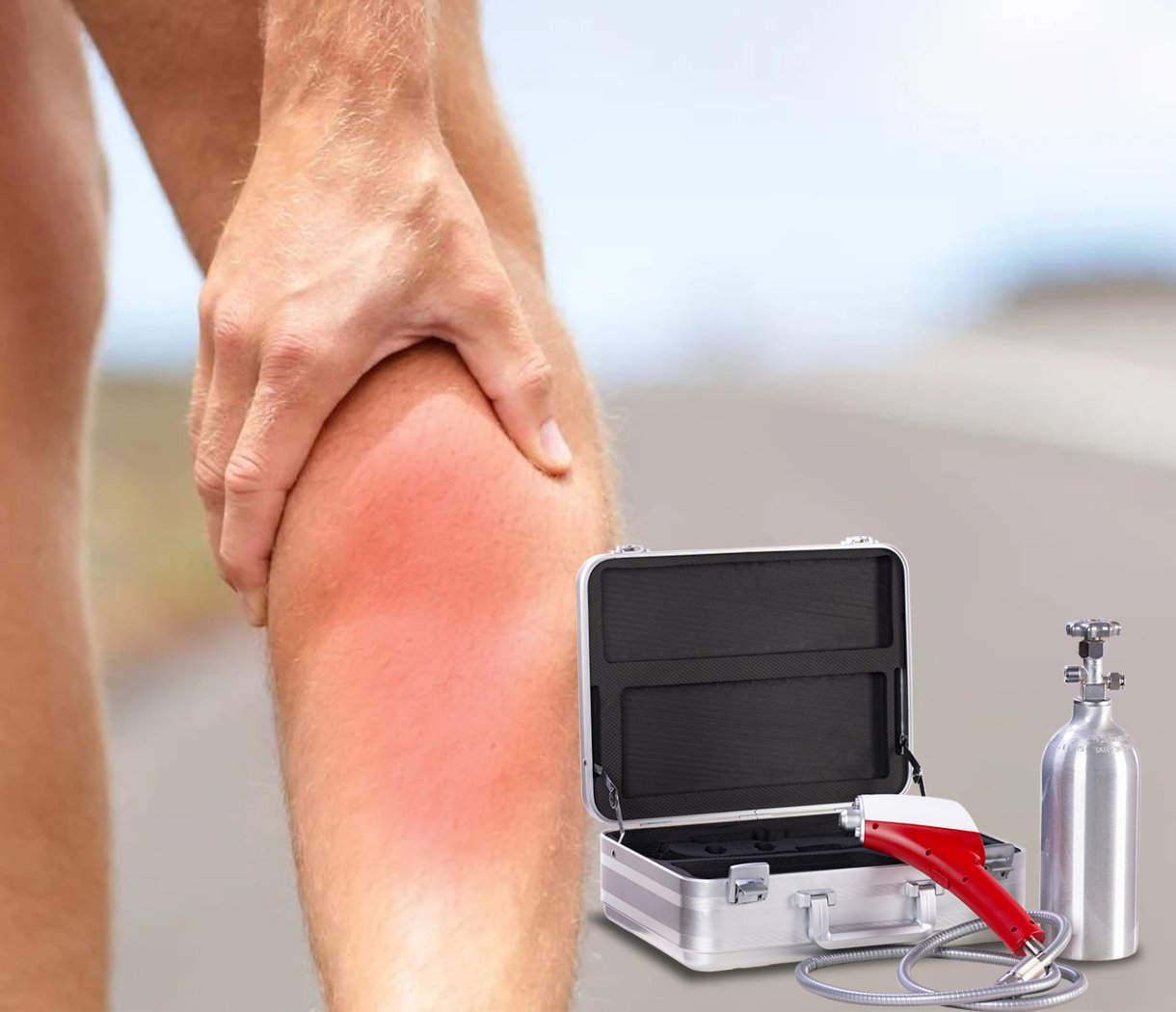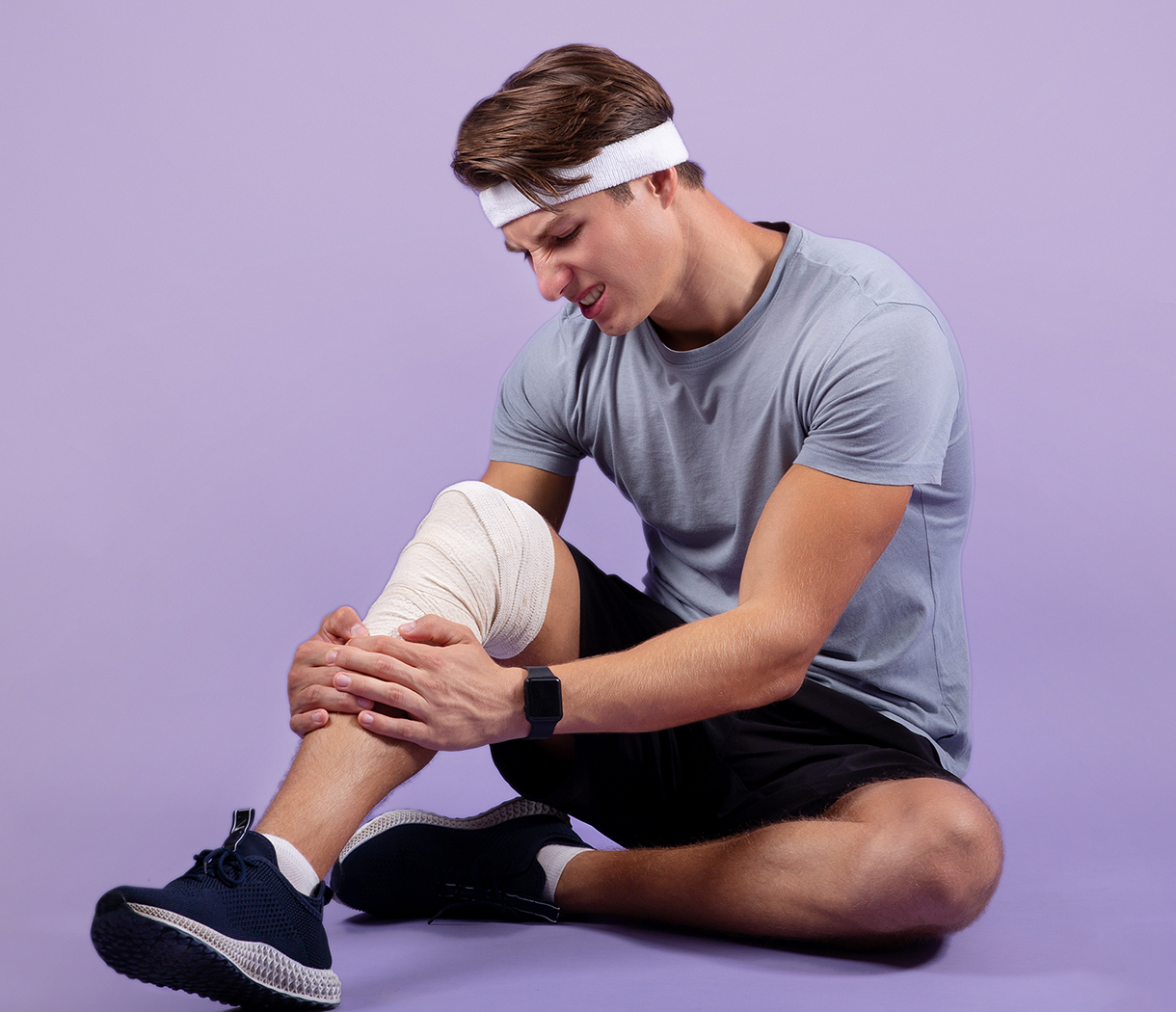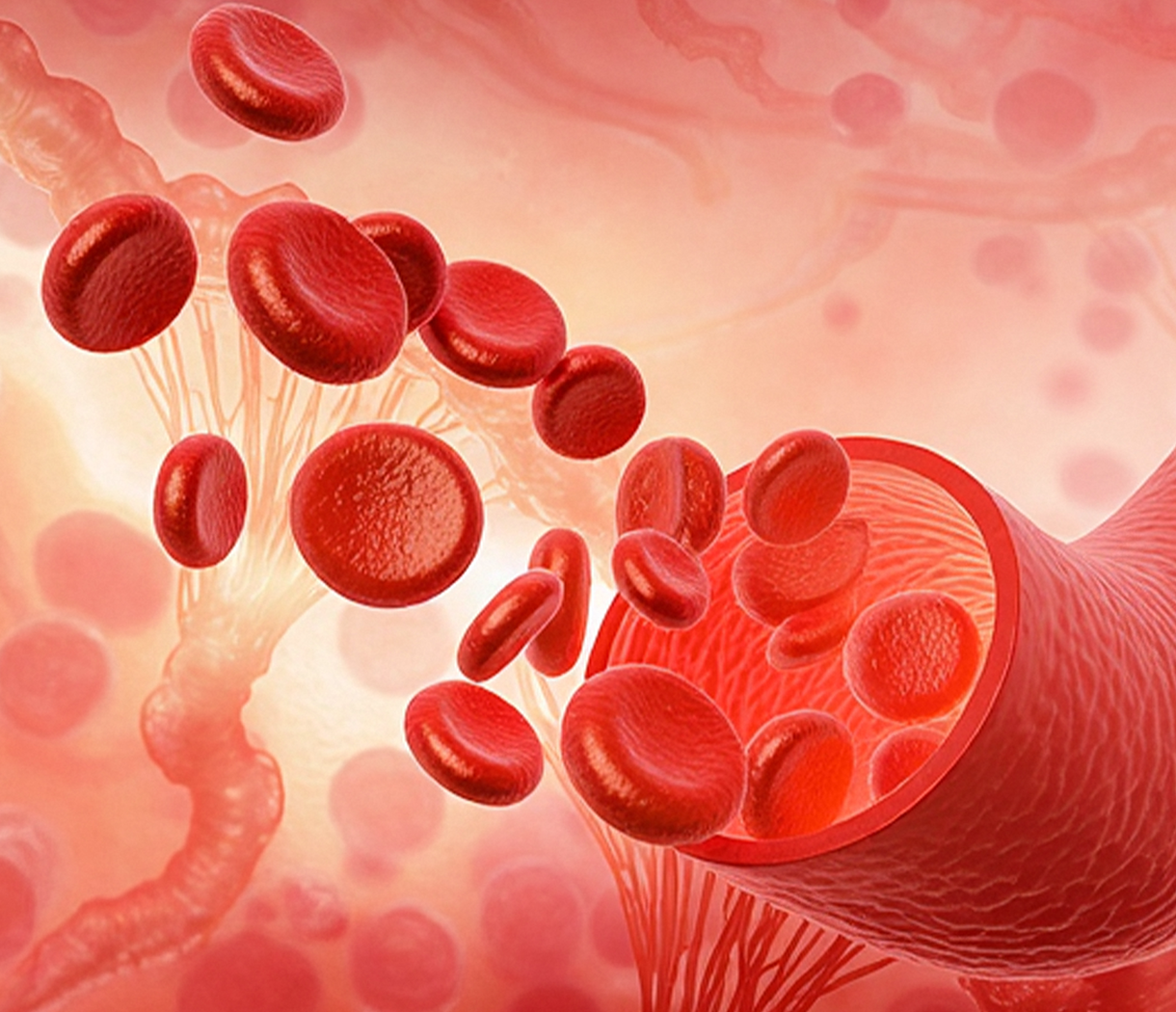The Basics of Cold Healing
Cryotherapy, or cold therapy, is a technique that utilizes extreme cold to treat various medical conditions. The primary mechanism involves reducing tissue temperature, leading to vasoconstriction (narrowing of blood vessels), which helps decrease blood flow, slow metabolism, and reduce inflammation. When the cold stimulus is removed, vasodilation (widening of blood vessels) occurs, improving circulation and accelerating recovery. Cryotherapy is widely recognized for its anti-inflammatory, analgesic (pain-relieving), and muscle-relaxing effects. By lowering the temperature of the treated area, it reduces swelling and pain, making it particularly useful for post-injury recovery, muscle soreness, and chronic conditions such as arthritis. Additionally, cryotherapy can help minimize nerve activity, which can be beneficial for neuropathic pain.
Whole-Body Cryotherapy: A Head-to-Toe Chill Session
Understanding Whole-Body Cryotherapy (WBC)
Whole-body cryotherapy (WBC) is a systemic cold therapy method in which individuals stand in a cryochamber at extreme subzero temperatures (-110°C to -160°C) for 1 to 3 minutes. Unlike traditional ice baths (0°C to 10°C), WBC offers a faster, more tolerable, and uniform cooling effect without direct contact with ice or water.
Mechanisms of Whole-Body Cryotherapy
Whole-body cryotherapy triggers multiple physiological responses, impacting the nervous, circulatory, and musculoskeletal systems.
Vasoconstriction & Rebound Vasodilation: Circulatory Adaptation
The first phase of cryotherapy involves vasoconstriction, which reduces peripheral blood flow. This helps decrease inflammation and pain by restricting the circulation to the affected areas. Once the individual exits the cryotherapy chamber, rebound vasodilation occurs. This process restores blood flow, promoting increased circulation and enhancing the delivery of oxygen and nutrients to tissues. This reaction accelerates muscle recovery and aids in the repair of damaged tissues. Clinical data supports these effects. A 2019 study in Sports Medicine found that Whole Body Cryotherapy (WBC) reduced inflammation markers, such as IL-6 and TNF-α, by 40% after just three sessions.

Here’s the bar chart showing the effect of cryotherapy on inflammatory markers (IL-6, TNF-α, CRP). The data indicates a significant reduction in inflammation after treatment.
Neurological Effects: Pain and Mood Regulation
Extreme cold exposure during cryotherapy stimulates the autonomic nervous system, causing a significant increase in norepinephrine levels—up to 10 times higher than normal. This spike in norepinephrine plays a key role in reducing pain perception. Cryotherapy also desensitizes nerve endings, specifically the C-fibers and A-delta fibers, which are responsible for transmitting pain signals. As a result, chronic pain is significantly reduced. Moreover, regular exposure to cold temperatures has mood-enhancing benefits. A 2017 study published in Frontiers in Psychology showed a 50% reduction in depressive symptoms following consistent use of Whole Body Cryotherapy.
Metabolic Effects: Fat Burning and Weight Loss
Cryotherapy induces thermogenesis, a process where cold exposure activates brown adipose tissue (BAT), which in turn increases calorie expenditure. This activation of BAT leads to a higher rate of fat burning, contributing to weight loss. Research supports these metabolic benefits. A study published in the Journal of Clinical Investigation found that a single Whole Body Cryotherapy session can burn between 500-800 kcal, which is comparable to the calories burned during a one-hour moderate-intensity workout. This makes cryotherapy an effective option for those looking to boost their metabolism and aid in weight management.
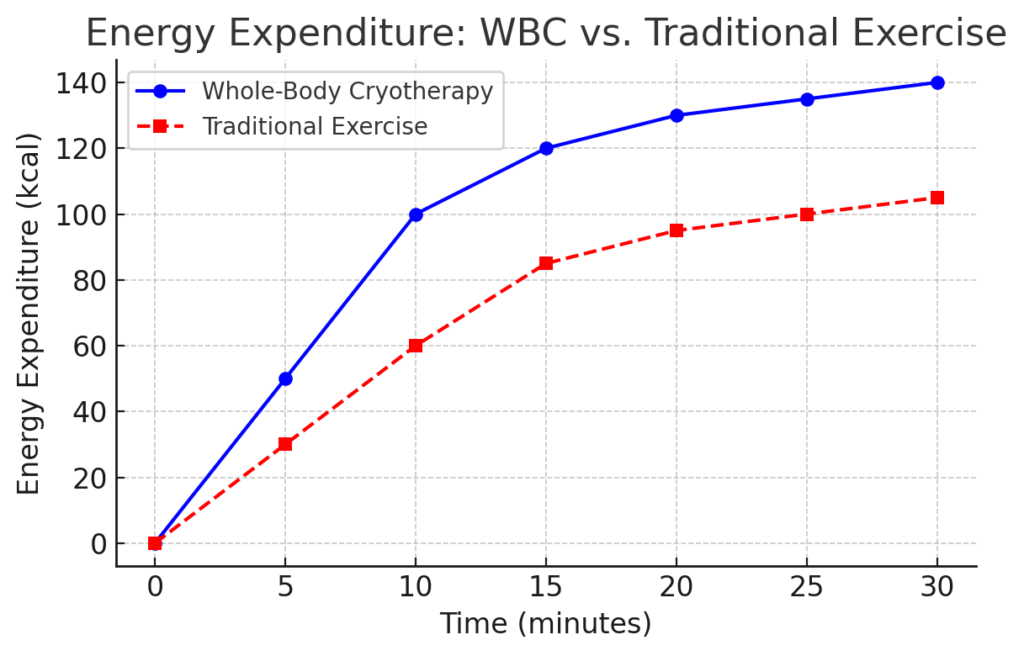
Here’s the line chart comparing energy expenditure between whole-body cryotherapy (WBC) and traditional exercise. WBC shows a faster increase in calorie burn, indicating its metabolic benefits.
Applications of Whole-Body Cryotherapy
Athletic Performance and Recovery
Whole-Body Cryotherapy (WBC) is widely used by elite athletes, including figures like LeBron James and Cristiano Ronaldo, who rely on it for muscle repair and recovery. The therapy helps reduce muscle soreness and accelerates recovery after intense training sessions or competitions. A study published in the Journal of Sports Science & Medicine found that WBC reduced muscle soreness by 33% and improved recovery time by 20%, making it a valuable tool for athletes seeking to maintain peak performance and shorten downtime between events.
Chronic Pain and Inflammatory Conditions
WBC has proven to be beneficial for managing chronic pain and inflammatory conditions such as arthritis, fibromyalgia, and multiple sclerosis (MS). The therapy’s anti-inflammatory and analgesic effects help alleviate pain and reduce swelling in affected areas. For example, a study published in the Journal of Rheumatology showed a 50% reduction in pain levels among rheumatoid arthritis (RA) patients after two weeks of regular WBC therapy, demonstrating its potential as a treatment for long-term pain relief.
Mental Health & Sleep Improvement
Cryotherapy has been linked to improvements in mental health by stimulating the production of endorphins and serotonin, which are known to help reduce anxiety, depression, and stress. These effects can contribute to an overall sense of well-being. Additionally, WBC has shown promising results for individuals with sleep disorders. A 2020 clinical trial in Sleep Science found that chronic insomniacs experienced a 30% improvement in sleep quality after undergoing regular WBC sessions, highlighting its potential as a non-invasive treatment for sleep-related issues.
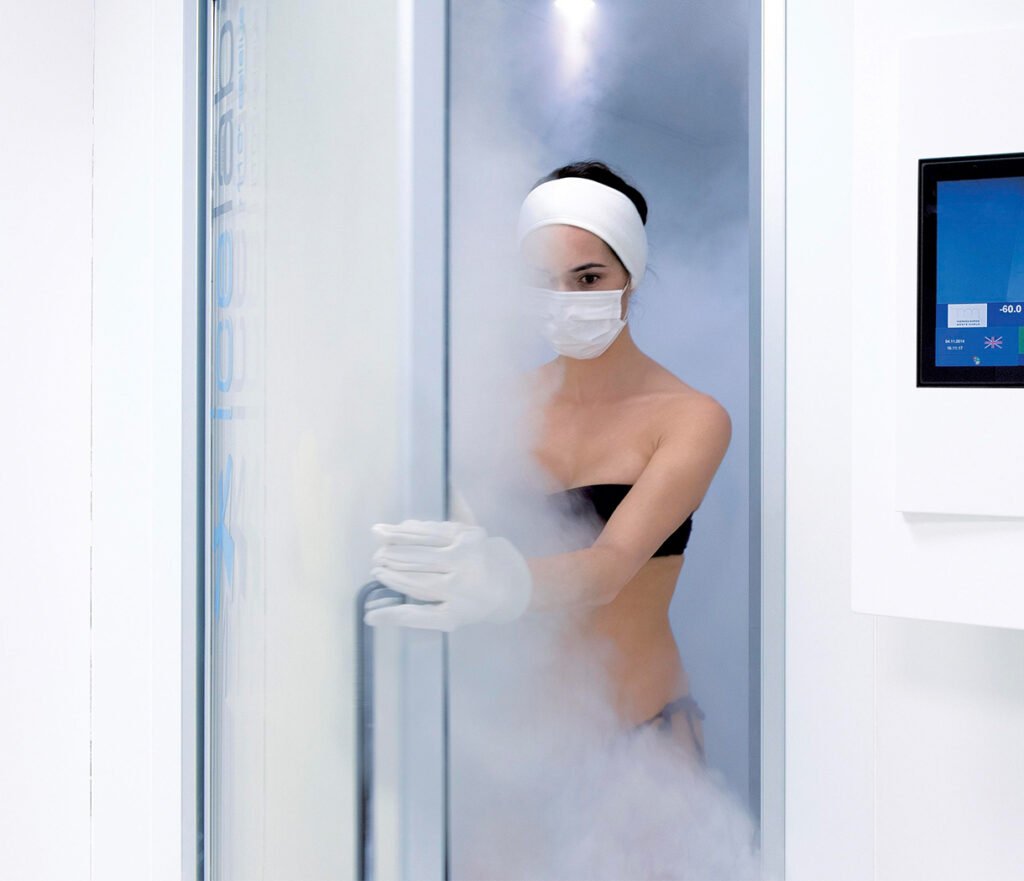
Risks and Considerations
Contraindications: While Whole-Body Cryotherapy offers numerous benefits, there are some contraindications to be aware of. It should be avoided by individuals with hypertension (especially those with readings above 180/100 mmHg), Raynaud’s disease, or severe cardiovascular disorders. These conditions can be aggravated by extreme cold exposure, making cryotherapy unsafe for those affected.
Potential side effects: Though generally well-tolerated, WBC may cause some temporary side effects. These can include numbness, dizziness, or skin redness, which usually resolve shortly after the session ends. It’s important to monitor for any adverse reactions and seek medical advice if necessary.
Safety measures: For safety, Whole-Body Cryotherapy sessions should always be conducted under professional supervision. The duration of each session should not exceed three minutes to minimize the risk of complications and ensure the treatment remains effective. This ensures that the benefits of cryotherapy can be safely enjoyed without undue risk to the individual’s health.
Localized Cryotherapy: Targeted Relief for Specific Areas
Understanding Localized Cryotherapy
Localized cryotherapy involves the application of extreme cold, ranging from -30°C to -80°C, directly to a specific area of the body. This is typically done using cold air jets, liquid nitrogen sprays, or cryotherapy probes. Unlike Whole-Body Cryotherapy (WBC), which affects the entire body, localized cryotherapy targets specific regions, making it highly effective for pain relief and treating localized injuries. By isolating the cold therapy to the problem area, it can provide more concentrated and focused benefits.
Mechanisms of Localized Cryotherapy
Localized cryotherapy works by subjecting a targeted area to focused cold exposure, which produces physiological effects similar to WBC but in a more concentrated form. The cold induces several processes that help alleviate pain and promote healing in the treated area.
Targeted Vasoconstriction & Swelling Reduction
When cold is applied to a localized area, blood vessels constrict, leading to a reduction in fluid accumulation and swelling. This vasoconstriction helps minimize inflammation in the affected area. A study published in Cryobiology (2018) demonstrated that localized cryotherapy reduced post-injury edema by 45%, compared to a 20% reduction with traditional ice packs, showing its superior effectiveness in managing swelling.
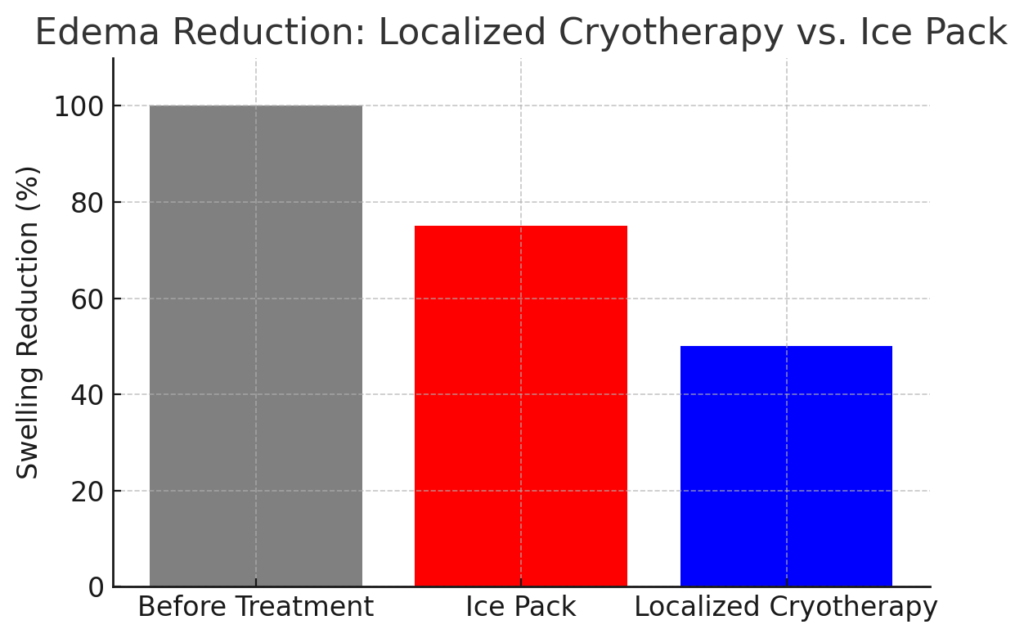
Here’s the bar chart comparing edema (swelling) reduction between an ice pack and localized cryotherapy. Localized cryotherapy shows superior effectiveness, reducing swelling by 50% compared to 25% with an ice pack.
Pain Reduction & Muscle Relaxation
Localized cold exposure also decreases nerve conduction velocity, which helps reduce pain perception, especially in conditions involving neuropathic pain or musculoskeletal disorders. It is particularly effective for conditions such as tendonitis, bursitis, and herniated discs. A study in The Journal of Pain Research (2021) found that patients who underwent localized cryotherapy reported 60% lower pain scores than those who used conventional icing methods, demonstrating its efficacy in pain management.
Enhanced Post-Surgical Recovery
Localized cryotherapy can significantly aid post-surgical recovery by reducing pain and inflammation. A 2020 study published in The Journal of Pain showed that patients who received localized cryotherapy after surgery experienced 30% less pain and used 25% fewer painkillers than those who did not receive cryotherapy, highlighting its role in enhancing recovery and reducing the need for medication.
Applications of Localized Cryotherapy
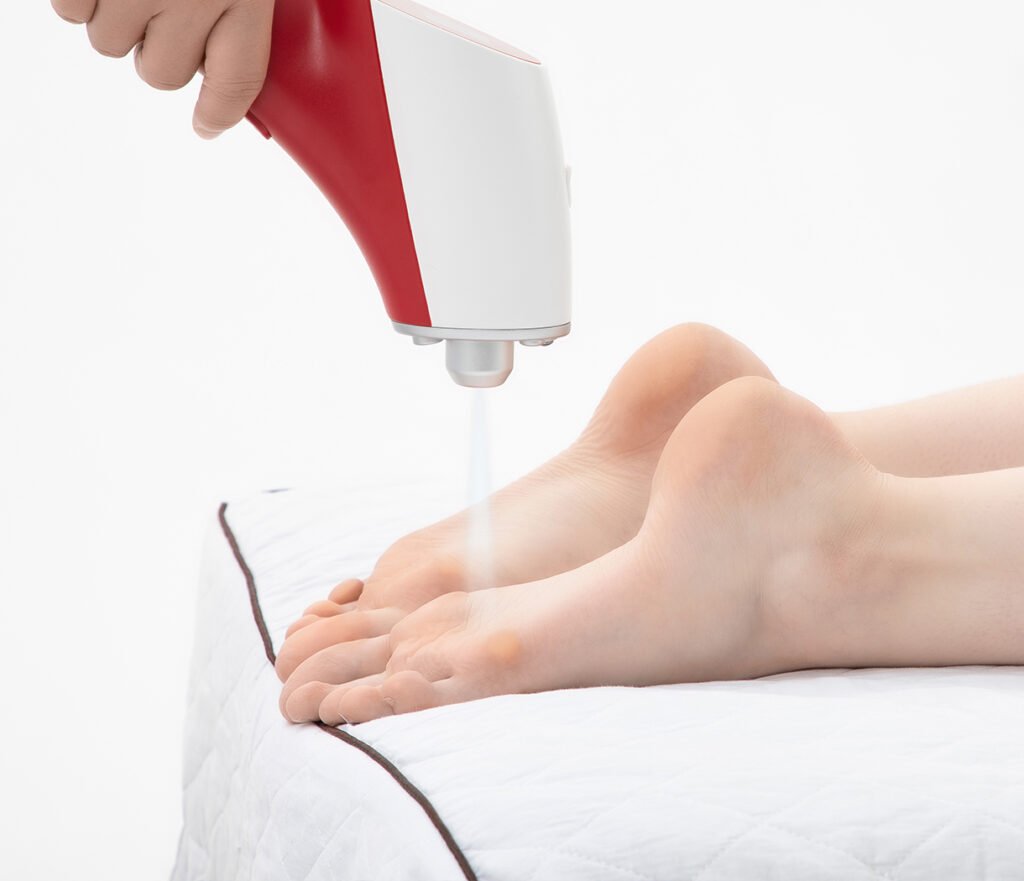
Joint and Muscle Pain Relief
Localized cryotherapy is highly effective in treating joint and muscle pain. It can provide relief for conditions such as arthritis, sciatica, and localized muscle spasms. By reducing inflammation and swelling, it helps alleviate discomfort and promote healing in targeted areas.
Injury Recovery & Rehabilitation
Localized cryotherapy is commonly used in physical therapy to accelerate the healing of ligament and tendon injuries. A clinical trial published in the American Journal of Sports Medicine found that localized cryotherapy reduced the healing time for ankle sprains by 50%, making it an essential tool for rehabilitation.
Skincare & Anti-Aging
In dermatology clinics, localized cryotherapy is used to treat a variety of skin conditions such as rosacea, acne, and to promote skin tightening. The cold exposure stimulates collagen production, which can help reduce the appearance of fine lines and wrinkles, offering an anti-aging benefit in addition to its therapeutic uses.
Risks and Considerations
Frostbite risk: One of the potential risks of localized cryotherapy is frostbite, particularly with prolonged exposure to extreme cold. To avoid this, it is essential that the treatment does not last for more than 5 minutes, as prolonged exposure can lead to skin damage.
Circulatory risk: Localized cryotherapy is not recommended for individuals with certain circulatory issues, particularly diabetic patients who may have impaired blood flow. The cold can worsen circulation problems, so those with conditions affecting circulation should avoid this treatment unless supervised by a healthcare professional.
Professional guidance recommended: For safety and optimal results, it is important to seek professional guidance when undergoing localized cryotherapy. Treatment should be administered under the supervision of a trained specialist, ensuring that the therapy is both effective and safe.
When to Choose One Over the Other
Comparing Treatment Scope and Effectiveness
Both Whole-Body Cryotherapy (WBC) and Localized Cryotherapy are powerful cold therapies, but their scopes and effectiveness vary. WBC involves full-body exposure to extremely cold air (-110°C to -140°C) for up to 3 minutes, which is highly effective for reducing overall inflammation, improving circulation, enhancing recovery, and boosting mood. This is ideal for individuals with generalized pain, inflammation, or sports recovery needs.
Localized Cryotherapy, on the other hand, targets specific areas, providing deeper cooling at temperatures of -30°C to -80°C. It’s more effective for treating isolated injuries, such as muscle strains, tendonitis, joint pain, or post-surgical recovery. A study in The Journal of Pain Research (2021) found that localized cryotherapy resulted in 60% greater pain reduction compared to conventional ice packs, making it a superior choice for localized relief.
Factors to Consider: Symptoms, Goals, and Conditions
When deciding between WBC and localized cryotherapy, consider the symptoms, goals, and specific conditions you aim to treat:
For general inflammation or full-body recovery: WBC is highly effective. It’s particularly beneficial for athletes who want to reduce overall inflammation, enhance recovery after intense training, or manage conditions like fibromyalgia, arthritis, and chronic pain.
For targeted pain relief or injury rehabilitation: Localized Cryotherapy is ideal. If you’re dealing with a sprain, strain, tendonitis, bursitis, or localized muscle pain, it’s the preferred treatment as it focuses cold directly on the injury site.
For mental health and mood regulation: If mood enhancement or reducing symptoms of anxiety or depression is the goal, WBC offers a broader impact due to its full-body activation of the autonomic nervous system, increasing norepinephrine levels by up to 10 times, as noted in studies published by Frontiers in Psychology (2017).
Can You Combine Both for Maximum Benefits?
Yes, combining both therapies can maximize the benefits for specific recovery and treatment goals. WBC can serve as an overall anti-inflammatory and recovery boost, while localized cryotherapy can provide targeted relief for injury sites. For example, athletes or individuals with chronic pain may benefit from a WBC session followed by localized cryotherapy to address specific pain points.
Research suggests combining therapies for enhanced results, such as using WBC for overall inflammation and localized cryotherapy for concentrated injury rehabilitation. A study in Sports Medicine (2019) found that combining WBC with other rehabilitation techniques (like physical therapy or cryotherapy) led to a 33% faster recovery time in athletes.
Which One Is Right for You? Making the Best Choice
Choosing between WBC and localized cryotherapy depends on your specific needs:
Choose WBC if:
- You need overall pain relief and inflammation reduction.
- You’re recovering from a full-body intense workout or injury.
- You seek to improve mood, sleep, or enhance energy levels.
Choose Localized Cryotherapy if:
- You have a specific injury, pain point, or musculoskeletal issue (e.g., joint pain, sprains, tendonitis).
- You’re looking for targeted relief for a localized area after surgery or injury.
- You want to improve skin condition (e.g., acne, rosacea, or skin tightening).
In both cases, it’s always beneficial to consult a healthcare provider to ensure you’re making the best decision based on your personal condition and goals.
If You Choose Localized Cryotherapy, Try CO2 Cryotherapy!
CO₂ cryotherapy is an advanced localized cryotherapy treatment that delivers pressurized carbon dioxide gas at -78°C to specific body areas, inducing rapid thermal shock. This sudden temperature drop triggers the body’s natural healing response, promoting muscle relaxation, reducing inflammation, and alleviating pain in just 10 seconds. The therapy works by delivering pressurized CO₂ gas to targeted areas, creating a rapid thermal shock that enhances recovery and pain relief. Its applications extend across various needs, from sports recovery to chronic pain management. For active individuals, portable CO₂ cryotherapy devices, such as the CO₂ Cryotherapy Gun, provide on-the-go relief, allowing users to target trouble spots anytime, anywhere. Athletes and fitness enthusiasts benefit from its ability to accelerate muscle recovery, boost performance, and reduce inflammation. Additionally, it offers effective relief for rheumatoid arthritis, helping to alleviate pain, reduce inflammation, and improve joint mobility. Compared to nitrogen-based cryotherapy, CO₂ therapy provides distinct advantages in temperature control, duration, and tissue penetration, ensuring efficient and effective relief. By incorporating localized CO₂ cryotherapy into your treatment routine, you gain access to a targeted, efficient, and portable solution for pain relief and recovery, making it a valuable tool for both clinical settings and personal use.
FAQs: Everything You Want to Know About Cryotherapy
Is Cryotherapy Safe?
Yes, cryotherapy is safe when performed by professionals. Sessions last 2-3 minutes for whole-body and 10 seconds for localized treatment. Following guidelines ensures minimal risks.
How Often Should I Use Cryotherapy?
For general wellness, 2-3 times a week is ideal. For injury recovery, daily sessions may help, especially in the early stages.
Are There Any Side Effects?
You may experience numbness, redness, tingling, or dizziness, but these effects fade quickly. Severe issues like frostbite are rare and happen only with overexposure.
When Will I See Results?
Many feel immediate pain relief and mood improvement after one session. Long-term benefits, like better muscle recovery and pain reduction, require regular sessions.
How Is Cryotherapy Different From Ice Packs?
Cryotherapy delivers colder temperatures more effectively, providing faster and deeper pain relief than ice packs. It also reduces inflammation more efficiently.
Can I Use Cryotherapy If I Have a Medical Condition?
People with high blood pressure, Raynaud’s disease, or heart issues should avoid cryotherapy. Always consult a doctor if you have health concerns.
Is There an Age Limit?
Cryotherapy is safe for adults, but not recommended for children under 12 unless supervised. Older adults with poor circulation or nerve issues should consult a doctor.
Can I Overuse Cryotherapy?
Yes, too much cryotherapy can cause frostbite, nerve damage, or circulation problems. Limit use to 3 sessions per week for safe and effective recovery.
How Does Cryotherapy Compare to Heat Therapy?
Cryotherapy reduces pain, swelling, and inflammation, while heat therapy improves blood flow and relaxes muscles. Use cryotherapy for acute injuries and heat therapy for chronic stiffness.
